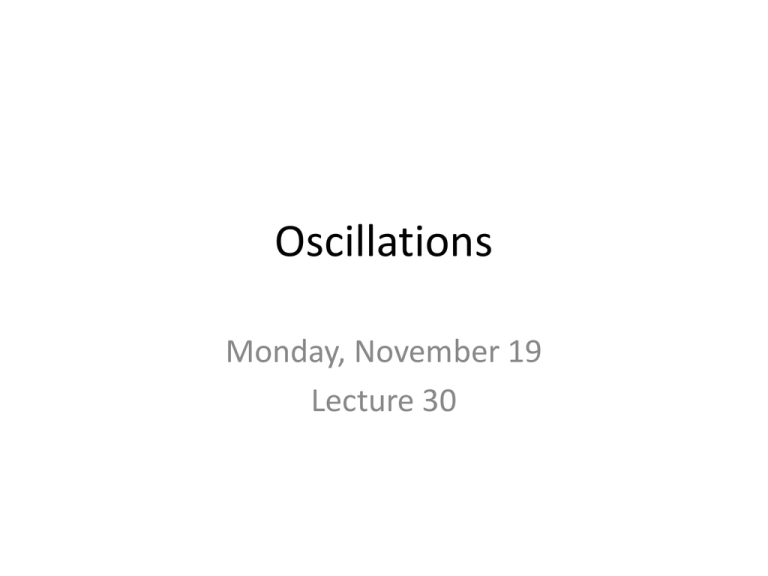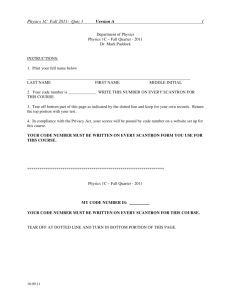Oscillations & SHM: Physics Presentation
advertisement

Oscillations Monday, November 19 Lecture 30 Workbook problems due Wednesday • WB 10.5, problems 14-25 Workbook Problems due Friday • Problems 14-1 through 8, pages 14-1 -- 5 Power • Power is the rate of transformation of energy E P t • Unit is 1 Watt=1W = 1 J/s • If energy being transformed is work, W then W F x x P F Fv t t t Is the work done by F + or - ? 1. Positive 2. negative 50% 50% e at iv ne g Po sit i d ve F Is the work done by F + or - ? 1. Positive 2. negative 50% 50% F e at iv ne g Po sit i ve d Is the work done by F + or - ? 1. Positive 2. negative 50% 50% e at iv ne g Po sit i d ve F Problem 10:20 • A pendulum is made by tying a 500g ball to a 75-cm-long string. The pendulum is pulled 300 to one side and then released. • A) What is the ball’s speed at the lowest point in its trajectory? • B) To what angle does the pendulum swing on the other side. Problem 10:20 • Use energy conservation 300 L=0.75 m Δy=L-Lcos 300 Problem 10:20 cont • Set y=0 at lowest point of swing U gi Ki U gf K f 1 2 mg y 0 0 mv 2 1 2 mgL(1 cos ) mv 2 v 2 gL(1 cos ) 1.4 m/s Problem 10:24 • A student places her 500g physics textbook on a frictionless table. She pushes the book against a spring 4.00cm and then releases the book. What is the book’s speed as it slides away? The spring constant is k = 1250 N/m. Problem 10:24 • A student places her 500g physics textbook on a frictionless table. She pushes the book against a spring 4.00cm and then releases the book. What is the book’s speed as it slides away? The spring constant is k = 1250 N/m. Problem 10:24 • Using the initial position as the compressed spring, final after book leaves spring: U Si Ki U sf K f 1 2 1 2 U Si kxi 1250 N / m (.04m) 2 2 Ki 0 U Sf 0 1 2 K f mv f 2 Problem 10:24 • Finally k 2 1250 N/m 2 vf xi (.0400cm) m 0.500 kg 2.00 m/s Equilibrium and Oscillation • Frequency and Period 1 f T 2 f Simple Harmonic Motion • Linear restoring force— – Example, mass on a spring FNET , y ky k m – Set y=0 at equilibrium point: – 2 t y(t ) A cos(t ) A cos(2 f ) A cos T Simple Harmonic Motion • If restoring force is linearly proportional to displacement (e.g. F=-kx) then we will have simple harmonic motion. • In lab last week you experimented with a simple pendulum. Was its motion simple harmonic? Fnet ,tangential mg sin mg θ T w cos θ w sin θ w Simple Pendulum Find the angular frequency is g L 1 1 T 2 2 L g Description of motion x(t ) A cos(t ) dx(t ) v(t ) A sin(t ) vMAX sin(t ) dt dv(t ) a(t ) 2 A cos(t ) 2 x(t ) dt x(t) vs. t 5 4 3 x(t) meters 2 1 x(t) 0 0 2 4 6 8 -1 v(t) -2 a(t) -3 -4 -5 t sec x(t) vs. t 4 3 2 x(t) meters 1 0 0 2 4 6 8 -1 -2 -3 -4 t sec a) At what time(s) is particle moving right at maximum speed? b) At what time(s) is particle moving right at maximum speed? c) At what time(s) is the speed zero? Problem 14:7 An air-track glider is attached to a spring. The glider is pulled to the right and released from rest at t=0s. It then oscillates with T=2.0s and vmax = 40cm/s a) A=? b) x(t=0.25s) = ? Problem 14.7 2 T 2s T vMAX A A .4m/s A= .4 0.127m x(t ) A cos(t ) 0.127 cos( t ) x(.25) .127 cos( (.25)) .0898 Wednesday Oscillations continued Problems CQ3,CQ9,MC18,MC19, 1, 4, 6, 7, 10











